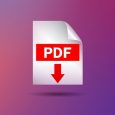The .pdf file extension refers to a portable document file. This name is appropriate when printing files and opening them on platforms other than those that created them. Let’s just say it: PDFs are versatile and convenient.
PDFs are especially suitable for printing since the printer or print shop doesn’t need to contend with multiple layers of content or incompatible file components.

Here, we’ll discuss some of the PDF format capabilities and why we believe it is the best format for multiple applications. What can a PDF do? Keep reading and find out!
Compatible
A PDF file opened on Windows, Mac, or Linux will look identical on each platform. Because the PDF format became an open standard in 2008, it has seen widespread applicability in most other software in use today. There is even a C# PDF library.
Portable
Portable refers to the capacity of the PDF with design assets in one file, including source images, placement, and preserving fonts.
Other file formats depend on the computer’s file system, where they were created to assemble these design elements—which can have awkward results.
Great Image Quality
PDF documents allow high-quality artwork to circulate efficiently by keeping the file size relatively small. Thus, they are ideal for sending finished artwork to print shops and other commercial printers.
PDFs are nowhere near as editable as those created using the original software. That isn’t the purpose of PDFs, though. Function-specific programs are for intricate editing, while PDFs are meant for portability.
Print shops can edit PDFs with Adobe Acrobat Pro for better printing outcomes, but the possibility of making further changes is minimal.
Reliable
Are you wondering, why is a PDF used for printing? Here’s your answer.
A PDF file is true to its source. Whatever types of data or formatting are incorporated in the original. If it is exported as a PDF, the resulting document looks virtually identical to that source.
Easy to Create and Export
Converting to PDF or not isn’t the real question here. People create most PDFs by exporting them from other programs, including Microsoft Word, Excel, and PowerPoint.
And as a standard component of Adobe Creative Suite, it can convert files from other CS programs, too. In fact, most programs today make it easy to change proprietary file formats to PDF.
Secure
It’s simple to secure a PDF file with a password. Doing so protects the contents of the PDF file from anyone not authorized to access it. Once a PDF file is password-protected, it can only be viewed by knowing and entering the right password.
Another way to secure a PDF file is by disabling its editing functions. That way, it can be viewed and read but not altered.
Reducible and Shareable
The PDF file format allows you to decrease a file’s size by reducing its quality and doing this is essential when sharing a particular file by e-mail or uploading it to a website. Many mail and messaging services limit the size of attachments.
What is a PDF for if not sharing? By using the PDF format to make a file smaller, you are more likely to find willing content editors and receive helpful comments from friends and coworkers.
Long Live the Portable Document!
We’ve made it clear why PDFs indeed are portable in many senses of the word. We’ve also explained why they make such excellent printing files. However, an attribute we haven’t mentioned is how to use them for sharing content while keeping it pristine.
If you’re wondering how PDF files do this so well, think of the MS Excel spreadsheet. Do you want to wade through all the embedded functions to see the final data, or would you rather see it laid out neatly and ready for printing and distribution?
And speaking of information, have you seen all the topics we cover on our website? If you haven’t, you’ll have some fun browsing through it all.




